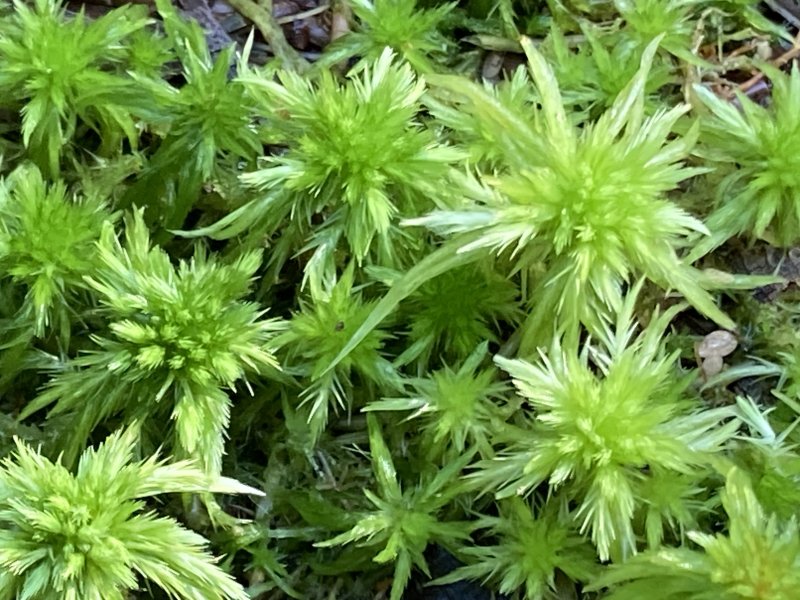Moss is a plant powerhouse that carpets the forest floor
A perfect autumn day for a walk in the woods. You know those days. The morning air has a cool edge, and low, ethereal clouds wrap each field in a moist embrace. Leaving the sun to dissipate the ground fog, I duck into the forest trail sheltering Abbott’s Pond. I stop to inhale scents of pine and damp leaves. The morning stillness radiates through the forest canopy as shafts of light highlight every shade of green.
In my daily life, I spend a lot of time sitting on the ground. In the shadows of Atlantic white cedar and tulip poplar giants, my view at the forest floor or “boundary layer” offers a different perspective. A green palette of mint, sage, lime, shamrock and jade highlights the small and important plant network of moss carpeting the surfaces near my feet.
Our earliest terrestrial plants (older than lichen) include a variety of moss, hornwort and liverwort species that are classified as “bryophytes.” They are true plants, not related to algae or fungi, yet they do not produce flowers or seeds. These ancient plants reproduce by fragmentation and also release spores like ferns do.
I gently touch the soft, emerald-colored moss called haircap (Polytrichum commune) growing in isolated clusters along the trail. It resembles a miniature forest with tiny evergreen trees. In the fall, vertical stems, each topped with a capsule, grow above the moss base. The capsule, or sporophyte, contains microscopic spores poised for close-range dispersal.
These small but mighty plants are found throughout the world. Look for them carpeting the ground, clinging to tree bark, spreading across rotting logs or plastered on rocks (during your adventures beyond our Cape Region). Most bryophytes are slow-growing plants seeking low light or shaded locations with moisture.
A smooth hornwort (Phaeoceras laevis) with pointy projections above a base of leafy rosettes may be the first plant in a disturbed, barren area to begin the reclamation process. As a pioneering species, bryophytes colonize nutrient-poor areas, break down rocks for soil and trap organic material, which will decompose to create a rich humus soil layer for the next succession of plants. By growing in extensive mats close to the ground, these plants also help control erosion while providing habitat for organisms that support a healthy network of roots under the surface.
Have you ever noticed how humid the air is in the forest on a hot, dry day? Bryophytes are able to retain and release moisture, providing a water delivery service essential to the environment. Many species, such as sphagnum moss, can hold 20 times their dry weight in water. Simply put, mosses regulate moisture levels during a drought.
Sitting under an Atlantic white cedar, I glide my fingertips over the velvety moss. Both of these plant species thrive in the ecotone between forests and wetland communities. They both have leaves with stomata — structures on the underside of the leaf that open to take in carbon dioxide for photosynthesis and release oxygen. So why are they so different? How does the cedar reach great heights with branching boughs heavy with scale-like needles and cones, while the spore-bearing common fern moss (Thuidium delicatulum) hugs the ground with extensive branches of flat, feather-like leaves?
It all comes down to internal structure. The cedar has roots and a superior vascular system to defy gravity and pump water up to the leaves via xylem, while phloem transports glucose down the trunk to the roots. Mosses do not have roots; they have rhizoids that attach them to a surface but do not take in water or nutrients. Colonizing the earth’s surface millions of years before flowering plants, these primitive plants have no vascular system. Each species has a simple structure with a central stem and hundreds of tiny leaves filled with chlorophyll to facilitate photosynthesis. Their extensive leaf surface area collects carbon dioxide and water directly from the rain or air.
As tempting as it is to walk down the lush green carpet, I step around the living mosses in my path. Mosses are sensitive. Many species are bioindicators, offering a snapshot of the air and water quality in a location. Each plant provides essential habitat, which includes food, water and shelter, for a variety of creatures, from microscopic invertebrates to the furred and feathered. Mosses occupy the boundary layer, a bridge connecting the surface and the underground in the forest ecosystem. Mosses are small and mighty plant powerhouses supporting the giants reaching the sky!














.AMM_.jpeg)
AMM.jpeg)







































